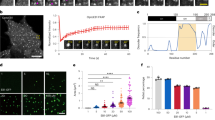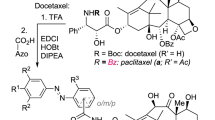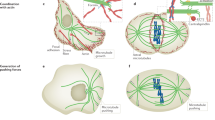Abstract
End-binding proteins (EBs) are adaptors that recruit functionally diverse microtubule plus-end-tracking proteins (+TIPs) to growing microtubule plus ends. To test with high spatial and temporal accuracy how, when and where +TIP complexes contribute to dynamic cell biology, we developed a photo-inactivated EB1 variant (π-EB1) by inserting a blue-light-sensitive protein–protein interaction module between the microtubule-binding and +TIP-binding domains of EB1. π-EB1 replaces endogenous EB1 function in the absence of blue light. By contrast, blue-light-mediated π-EB1 photodissociation results in rapid +TIP complex disassembly, and acutely and reversibly attenuates microtubule growth independent of microtubule end association of the microtubule polymerase CKAP5 (also known as ch-TOG and XMAP215). Local π-EB1 photodissociation allows subcellular control of microtubule dynamics at the second and micrometre scale, and elicits aversive turning of migrating cancer cells. Importantly, light-mediated domain splitting can serve as a template to optically control other intracellular protein activities.
This is a preview of subscription content, access via your institution
Access options
Access Nature and 54 other Nature Portfolio journals
Get Nature+, our best-value online-access subscription
$29.99 / 30 days
cancel any time
Subscribe to this journal
Receive 12 print issues and online access
$209.00 per year
only $17.42 per issue
Buy this article
- Purchase on SpringerLink
- Instant access to full article PDF
Prices may be subject to local taxes which are calculated during checkout






Similar content being viewed by others
References
Ohi, R. & Zanic, M. Ahead of the curve: new insights into microtubule dynamics. F1000Res. 5, 314 (2016).
Akhmanova, A. & Steinmetz, M. O. Control of microtubule organization and dynamics: two ends in the limelight. Nat. Rev. Mol. Cell. Biol. 16, 711–726 (2015).
Kumar, P. & Wittmann, T. +TIPs: SxIPping along microtubule ends. Trends Cell Biol. 22, 418–428 (2012).
Kumar, P. et al. GSK3beta phosphorylation modulates CLASP–microtubule association and lamella microtubule attachment. J. Cell. Biol. 184, 895–908 (2009).
Pemble, H., Kumar, P., van Haren, J. & Wittmann, T. GSK3-mediated CLASP2 phosphorylation modulates kinetochore dynamics. J. Cell. Sci. 130, 1404–1412 (2017).
Smyth, J. T. et al. Phosphoregulation of STIM1 leads to exclusion of the endoplasmic reticulum from the mitotic spindle. Curr. Biol. 22, 1487–1493 (2012).
van der Vaart, B. et al. SLAIN2 links microtubule plus end-tracking proteins and controls microtubule growth in interphase. J. Cell. Biol. 193, 1083–1099 (2011).
van Haren, J. et al. Dynamic microtubules catalyze formation of navigator–TRIO complexes to regulate neurite extension. Curr. Biol. 24, 1778–1785 (2014).
Wu, X. et al. Skin stem cells orchestrate directional migration by regulating microtubule–ACF7 connections through GSK3beta. Cell 144, 341–352 (2011).
Montenegro, G. S. et al. In vitro reconstitution of the functional interplay between MCAK and EB3 at microtubule plus ends. Curr. Biol. 20, 1717–1722 (2010).
Maurer, S. P. et al. EBs recognize a nucleotide-dependent structural cap at growing microtubule ends. Cell 149, 371–382 (2012).
Zhang, R., Alushin, G. M., Brown, A. & Nogales, E. Mechanistic origin of microtubule dynamic instability and its modulation by EB proteins. Cell 162, 849–859 (2015).
Honnappa, S. et al. An EB1-binding motif acts as a microtubule tip localization signal. Cell 138, 366–376 (2009).
Repina, N. A. et al. At light speed: advances in optogenetic systems for regulating cell signaling and behavior. Annu. Rev. Chem. Biomol. Eng. 8, 13–39 (2017).
Wang, H. et al. LOVTRAP: an optogenetic system for photoinduced protein dissociation. Nat. Methods 13, 755–758 (2016).
Slep, K. C. & Vale, R. D. Structural basis of microtubule plus end tracking by XMAP215, CLIP-170, and EB1. Mol. Cell. 27, 976–991 (2007).
Komarova, Y. et al. Mammalian end binding proteins control persistent microtubule growth. J. Cell. Biol. 184, 691–706 (2009).
Skube, S. B., Chaverri, J. M. & Goodson, H. V. Effect of GFP tags on the localization of EB1 and EB1 fragments in vivo. Cytoskelet. (Hoboken) 67, 1–12 (2010).
Dragestein, K. A. et al. Dynamic behavior of GFP-CLIP-170 reveals fast protein turnover on microtubule plus ends. J. Cell. Biol. 180, 729–737 (2008).
Seetapun, D. et al. Estimating the microtubule GTP cap size in vivo. Curr. Biol. 22, 1681–1687 (2012).
Yan, X., Habedanck, R. & Nigg, E. A. A complex of two centrosomal proteins, CAP350 and FOP, cooperates with EB1 in microtubule anchoring. Mol. Biol. Cell. 17, 634–644 (2006).
Wang, T. et al. Translating mRNAs strongly correlate to proteins in a multivariate manner and their translation ratios are phenotype specific. Nucleic Acids Res. 41, 4743–4754 (2013).
Miller, P. M. et al. Golgi-derived CLASP-dependent microtubules control Golgi organization and polarized trafficking in motile cells. Nat. Cell. Biol. 11, 1069–1080 (2009).
De Groot, C. O. et al. Molecular insights into mammalian end-binding protein heterodimerization. J. Biol. Chem. 285, 5802–5814 (2010).
Christie, J. M. et al. Steric interactions stabilize the signaling state of the LOV2 domain of phototropin 1. Biochemistry 46, 9310–9319 (2007).
Ettinger, A. & Wittmann, T. Fluorescence live cell imaging. Methods Cell. Biol. 123, 77–94 (2014).
Gierke, S. & Wittmann, T. EB1-recruited microtubule +TIP complexes coordinate protrusion dynamics during 3D epithelial remodeling. Curr. Biol. 22, 753–762 (2012).
Bieling, P. et al. CLIP-170 tracks growing microtubule ends by dynamically recognizing composite EB1/tubulin-binding sites. J. Cell. Biol. 183, 1223–1233 (2008).
Kaverina, I. & Straube, A. Regulation of cell migration by dynamic microtubules. Semin. Cell. Dev. Biol. 22, 968–974 (2011).
Wittmann, T., Bokoch, G. M. & Waterman-Storer, C. M. Regulation of leading edge microtubule and actin dynamics downstream of Rac1. J. Cell. Biol. 161, 845–851 (2003).
Brouhard, G. J. et al. XMAP215 is a processive microtubule polymerase. Cell 132, 79–88 (2008).
Nakamura, S. et al. Dissecting the nanoscale distributions and functions of microtubule-end-binding proteins EB1 and ch-TOG in interphase HeLa cells. PLoS. ONE 7, e51442 (2012).
Bouchet, B. P. et al. Mesenchymal cell invasion requires cooperative regulation of persistent microtubule growth by SLAIN2 and CLASP1. Dev. Cell. 39, 708–723 (2016).
Etienne-Manneville, S. Microtubules in cell migration. Annu. Rev. Cell. Dev. Biol. 29, 471–499 (2013).
Wittmann, T. & Waterman-Storer, C. M. Cell motility: can Rho GTPases and microtubules point the way? J. Cell. Sci. 114, 3795–3803 (2001).
Bouchet, B. P. & Akhmanova, A. Microtubules in 3D cell motility. J. Cell. Sci. 130, 39–50 (2017).
Duellberg, C. et al. Reconstitution of a hierarchical +TIP interaction network controlling microtubule end tracking of dynein. Nat. Cell. Biol. 16, 804–811 (2014).
Usherenko, S. et al. Photo-sensitive degron variants for tuning protein stability by light. BMC Syst. Biol. 8, 128 (2014).
Nihongaki, Y., Kawano, F., Nakajima, T. & Sato, M. Photoactivatable CRISPR–Cas9 for optogenetic genome editing. Nat. Biotechnol. 33, 755–760 (2015).
Dagliyan, O. et al. Engineering extrinsic disorder to control protein activity in living cells. Science 354, 1441–1444 (2016).
Kumar, A. et al. Short linear sequence motif LxxPTPh targets diverse proteins to growing microtubule ends. Structure 25, 924–932 (2017).
Vitre, B. et al. EB1 regulates microtubule dynamics and tubulin sheet closure in vitro. Nat. Cell. Biol. 10, 415–421 (2008).
Maurer, S. P. et al. EB1 accelerates two conformational transitions important for microtubule maturation and dynamics. Curr. Biol. 24, 372–384 (2014).
Duellberg, C., Cade, N. I., Holmes, D. & Surrey, T. The size of the EB cap determines instantaneous microtubule stability. eLife 5, e13470 (2016).
Stehbens, S. J. et al. CLASPs link focal-adhesion-associated microtubule capture to localized exocytosis and adhesion site turnover. Nat. Cell. Biol. 16, 558–573 (2014).
Mitchison, T. J. The proliferation rate paradox in antimitotic chemotherapy. Mol. Biol. Cell. 23, 1–6 (2012).
Borowiak, M. et al. Photoswitchable inhibitors of microtubule dynamics optically control mitosis and cell death. Cell 162, 403–411 (2015).
Adikes, R. C., Hallett, R. A., Saway, B. F., Kuhlman, B. & Slep, K. C. Control of microtubule dynamics using an optogenetic microtubule plus end–F-actin cross-linker. J. Cell Biol. 217, jcb.201705190 (2017).
Akhmanova, A. et al. Clasps are CLIP-115 and -170 associating proteins involved in the regional regulation of microtubule dynamics in motile fibroblasts. Cell 104, 923–935 (2001).
Wu, Y. I. et al. A genetically encoded photoactivatable Rac controls the motility of living cells. Nature 461, 104–108 (2009).
Strickland, D. et al. TULIPs: tunable, light-controlled interacting protein tags for cell biology. Nat. Methods 9, 379–384 (2012).
Ran, F. A. et al. Genome engineering using the CRISPR–Cas9 system. Nat. Protoc. 8, 2281–2308 (2013).
van Haren, J. & Wittmann, T. Generation of cell lines with light-controlled microtubule dynamics. Protoc. Exch., https://doi.org/10.1038/protex.2017.155 (2018).
Stehbens, S., Pemble, H., Murrow, L. & Wittmann, T. Imaging intracellular protein dynamics by spinning disk confocal microscopy. Methods Enzymol. 504, 293–313 (2012).
Schindelin, J. et al. Fiji: an open-source platform for biological-image analysis. Nat. Methods 9, 676–682 (2012).
Ettinger, A., van Haren, J., Ribeiro, S. A. & Wittmann, T. Doublecortin is excluded from growing microtubule ends and recognizes the GDP-microtubule lattice. Curr. Biol. 26, 1549–1555 (2016).
Matov, A. et al. Analysis of microtubule dynamic instability using a plus-end growth marker. Nat. Methods 7, 761–768 (2010).
Jaqaman, K. et al. Robust single-particle tracking in live-cell time-lapse sequences. Nat. Methods 5, 695–702 (2008).
Meijering, E., Dzyubachyk, O. & Smal, I. Methods for cell and particle tracking. Methods Enzymol. 504, 183–200 (2012).
Stehbens, S. J. & Wittmann, T. Analysis of focal adhesion turnover: a quantitative live-cell imaging example. Methods Cell Biol. 123, 335–346 (2014).
Brown, A. M. A step-by-step guide to non-linear regression analysis of experimental data using a Microsoft Excel spreadsheet. Comput. Methods Prog. Biomed. 65, 191–200 (2001).
Acknowledgements
This work was supported by the NIH grants R01 GM079139, R01 GM094819 and S10 RR26758 to T.W., and P41 EB002025 and R35 GM122596 to K.M.H. We thank all members of the Cell and Tissue Biology community for discussions and comments on the manuscript.
Author information
Authors and Affiliations
Contributions
J.v.H. and T.W. designed the experiments, analysed the data and wrote the manuscript. J.v.H. performed most of the experiments and generated most of the reagents. A.E. and R.A.C. contributed to reagent generation and experimental work. H.W. and K.M.H. contributed unpublished reagents.
Corresponding author
Ethics declarations
Competing interests
The authors declare no competing financial interests.
Additional information
Publisher’s note: Springer Nature remains neutral with regard to jurisdictional claims in published maps and institutional affiliations.
Supplementary information
Supplementary Information
Supplementary Figures 1–5, and Supplementary Table and Supplementary Video descriptions.
In the version of the Supplementary Information originally published with this Article, Supplementary Tables 2 and 3 were incorrectly described as ‘List of antibodies’ and ‘List of PCR primer and gRNA sequences’, respectively. The correct descriptions are ‘List of PCR primers and gRNA sequences’ for Supplementary Table 2, and ‘Statistics source data’ for Supplementary Table 3. In addition, Supplementary Video 7 was incorrectly described as ‘Local control of MT growth. CKAP5 association with MT ends is independent of π-EB1 photo-dissociation’. The correct description is ‘CKAP5 association with MT ends is independent of π-EB1 photo-dissociation’. These errors have now been corrected. Further, Supplementary Figures 1–5 of the Supplementary Information file published were of low quality. The file has now been replaced to rectify this.
Supplementary Table 1
List of antibodies.
Supplementary Table 2
List of PCR primers and gRNA sequences.
Supplementary Table 3
Statistics source data.
Videos
Supplementary Video 1
Light-mediated SLAIN2 dissociation from MT ends in a π-EB1/EB1 shRNA cell.
Supplementary Video 2
Spatiotemporal control of π-EB1 photo-dissociation.
Supplementary Video 3
Reversible inhibition of MT growth by π-EB1 photo-dissociation.
Supplementary Video 4
Local control of MT growth
Supplementary Video 5
Light-induced MT depolymerization by π-EB1 photo-dissociation.
Supplementary Video 6
Light-induced MT reorganization by π-EB1 photo-dissociation.
Supplementary Video 7
CKAP5 association with MT ends is independent of π-EB1 photo-dissociation.
Supplementary Video 8
CKAP5 dynamics in EB1/3–/– cells.
Supplementary Video 9
Light-induced MT growth inhibition in π-EB1-expressing EB1/3–/– cells.
Supplementary Video 10
π-EB1-expressing EB1/3–/– cell trapped in a virtual blue light box.
Rights and permissions
About this article
Cite this article
van Haren, J., Charafeddine, R.A., Ettinger, A. et al. Local control of intracellular microtubule dynamics by EB1 photodissociation. Nat Cell Biol 20, 252–261 (2018). https://doi.org/10.1038/s41556-017-0028-5
Received:
Accepted:
Published:
Issue Date:
DOI: https://doi.org/10.1038/s41556-017-0028-5
This article is cited by
-
Force-transducing molecular ensembles at growing microtubule tips control mitotic spindle size
Nature Communications (2024)
-
circSETD3 regulates MAPRE1 through miR-615-5p and miR-1538 sponges to promote migration and invasion in nasopharyngeal carcinoma
Oncogene (2021)
-
Dynamic crotonylation of EB1 by TIP60 ensures accurate spindle positioning in mitosis
Nature Chemical Biology (2021)
-
Regulation of microtubule dynamics, mechanics and function through the growing tip
Nature Reviews Molecular Cell Biology (2021)
-
Phase-Field Modeling of Individual and Collective Cell Migration
Archives of Computational Methods in Engineering (2021)



